Analyzing Land-Use Change Scenarios for Ecosystem Services and their Trade-Offs in the Ecological Conservation Area in Beijing, China
Abstract
1. Introduction
2. Materials and Methods
2.1. Study Area
2.2. Data Preparation and Analysis
2.3. Future Scenarios Designing
2.4. Future Land-Use Modelling
2.5. Ecosystem Services Evaluations
2.5.1. Carbon Storage and Sequestration (CS)
2.5.2. Flood Regulation (FR)
2.5.3. Soil Conservation (SC)
2.5.4. Water Purification (WP)
2.5.5. Habitat Quality (HQ)
2.5.6. Crop Production (CP)
2.5.7. Sum of Ecosystem Services (SES)
2.6. Calculation of the Trade-Offs of ES
3. Results
3.1. Land-Use Changes Between 2000 and 2030
3.2. Changes of Ecosystem Services Between 2000 and 2030
3.3. Changes in SES in the ECA From 2000 to 2030
3.4. Trade-Offs and Synergies Among Ecosystem Services
4. Discussion
4.1. Impacts of Land-Use Change on Ecosystem Services
4.2. Strategies and Implications
4.3. Limitations and Future Perspectives
5. Conclusions
Supplementary Materials
Author Contributions
Funding
Conflicts of Interest
References
- Costanza, R.; D’Arge, R.; De Groot, R.; Farber, S.; Grasso, M.; Hannon, B.; Limburg, K.; Naeem, S.; O’Neill, R.V.; Paruelo, J.; et al. The value of the world’s ecosystem services and natural capital. Nature 1997, 387, 253–260. [Google Scholar] [CrossRef]
- Millennium Ecosystem Assessment. Ecosystems and Human Well-being: Synthesis; Island Press: Washington, DC, USA, 2005. [Google Scholar]
- Foley, J.A.; DeFries, R.; Asner, G.P.; Barford, C.; Bonan, G.; Carpenter, S.R.; Chapin, F.S.; Coe, M.T.; Daily, G.C.; Gibbs, H.K.; et al. Global Consequences of Land Use. Science 2005, 309, 570–574. [Google Scholar] [CrossRef] [PubMed]
- Lawler, J.J.; Lewis, D.J.; Nelson, E.; Plantinga, A.J.; Polasky, S.; Withey, J.C.; Helmers, D.P.; Martinuzzi, S.; Pennington, D.; Radeloff, V.C. Projected land-use change impacts on ecosystem services in the United States. Proc. Natl. Acad. Sci. USA 2014, 111, 7492–7497. [Google Scholar] [CrossRef] [PubMed]
- He, C.; Liu, Z.; Tian, J.; Ma, Q. Urban expansion dynamics and natural habitat loss in China: A multiscale landscape perspective. Glob. Chang. Biol. 2014, 20, 2886–2902. [Google Scholar] [CrossRef] [PubMed]
- Gomes, L.C.; Bianchi, F.J.J.A.; Cardoso, I.M.; Filho, E.I.F.; Schulte, R.P.O. Land use change drives the spatio-temporal variation of ecosystem services and their interactions along an altitudinal gradient in Brazil. Landsc. Ecol. 2020, 35, 1571–1586. [Google Scholar] [CrossRef]
- Roopsind, A.; Caughlin, T.T.; Hout, P.V.D.; Arets, E.; Putz, F.E. Trade-offs between carbon stocks and timber recovery in tropical forests are mediated by logging intensity. Glob. Chang. Biol. 2018, 24, 2862–2874. [Google Scholar] [CrossRef]
- Bai, Y.; Chen, Y.; Alatalo, J.M.; Yang, Z.; Jiang, B. Scale effects on the relationships between land characteristics and ecosystem services—A case study in Taihu Lake Basin, China. Sci. Total Environ. 2020, 716, 137083. [Google Scholar] [CrossRef]
- Groot, J.C.J.; Yalew, S.G.; Rossing, W.A.H. Exploring ecosystem services trade-offs in agricultural landscapes with a multi-objective programming approach. Landsc. Urban Plan. 2018, 172, 29–36. [Google Scholar] [CrossRef]
- Li, Z.; Cheng, X.; Han, H. Future Impacts of Land Use Change on Ecosystem Services under Different Scenarios in the Ecological Conservation Area, Beijing, China. Forests 2020, 11, 584. [Google Scholar] [CrossRef]
- Wang, Y.; Li, X.; Zhang, Q.; Li, J.; Zhou, X. Projections of future land use changes: Multiple scenarios-based impacts analysis on ecosystem services for Wuhan city, China. Ecol. Indic. 2018, 94, 430–445. [Google Scholar] [CrossRef]
- Gong, J.; Liu, D.; Zhang, J.; Xie, Y.; Cao, E.; Li, H. Tradeoffs/synergies of multiple ecosystem services based on land use simulation in a mountain-basin area, western China. Ecol. Indic. 2019, 99, 283–293. [Google Scholar] [CrossRef]
- Shoemaker, D.A.; Bendor, T.K.; Meentemeyer, R.K. Anticipating trade-offs between urban patterns and ecosystem service production: Scenario analyses of sprawl alternatives for a rapidly urbanizing region. Comput. Environ. Urban Syst. 2019, 74, 114–125. [Google Scholar] [CrossRef]
- Zhang, Z.; Liu, Y.; Wang, Y.; Liu, Y.; Zhang, Y.; Zhang, Y. What factors affect the synergy and tradeoff between ecosystem services, and how, from a geospatial perspective? J. Clean. Prod. 2020, 257, 120454. [Google Scholar] [CrossRef]
- Braun, D.; Damm, A.; Hein, L.; Petchey, O.L.; Schaepman, M. Spatio-temporal trends and trade-offs in ecosystem services: An Earth observation based assessment for Switzerland between 2004 and 2014. Ecol. Indic. 2018, 89, 828–839. [Google Scholar] [CrossRef]
- Wang, L.; Zheng, H.; Wen, Z.; Liu, L.; Robinson, B.E.; Li, R.; Li, C.; Kong, L. Ecosystem service synergies/trade-offs informing the supply-demand match of ecosystem services: Framework and application. Ecosyst. Serv. 2019, 37, 100939. [Google Scholar] [CrossRef]
- Pickard, B.R.; Van Berkel, D.; Petrasova, A.; Meentemeyer, R.K. Forecasts of urbanization scenarios reveal trade-offs between landscape change and ecosystem services. Landsc. Ecol. 2016, 32, 617–634. [Google Scholar] [CrossRef]
- Zhang, D.; Huang, Q.; He, C.; Yin, D.; Liu, Z. Planning urban landscape to maintain key ecosystem services in a rapidly urbanizing area: A scenario analysis in the Beijing-Tianjin-Hebei urban agglomeration, China. Ecol. Indic. 2019, 96, 559–571. [Google Scholar] [CrossRef]
- Wu, Y.; Tao, Y.; Yang, G.; Ou, W.; Pueppke, S.; Sun, X.; Chen, G.; Tao, Q. Impact of land use change on multiple ecosystem services in the rapidly urbanizing Kunshan City of China: Past trajectories and future projections. Land Use Policy 2019, 85, 419–427. [Google Scholar] [CrossRef]
- Liu, X.; Liang, X.; Li, X.; Xu, X.; Ou, J.; Chen, Y.; Li, S.; Wang, S.; Pei, F. A future land use simulation model (FLUS) for simulating multiple land use scenarios by coupling human and natural effects. Landsc. Urban Plan. 2017, 168, 94–116. [Google Scholar] [CrossRef]
- Aburas, M.M.; Ho, Y.M.; Ramli, M.F.; Ash’Aari, Z.H. Improving the capability of an integrated CA-Markov model to simulate spatio-temporal urban growth trends using an Analytical Hierarchy Process and Frequency Ratio. Int. J. Appl. Earth Obs. Geoinf. 2017, 59, 65–78. [Google Scholar] [CrossRef]
- Basse, R.M.; Omrani, H.; Charif, O.; Gerber, P.; Bódis, K. Land use changes modelling using advanced methods: Cellular automata and artificial neural networks. The spatial and explicit representation of land cover dynamics at the cross-border region scale. Appl. Geogr. 2014, 53, 160–171. [Google Scholar] [CrossRef]
- Etemadi, H.; Smoak, J.M.; Karami, J. Land use change assessment in coastal mangrove forests of Iran utilizing satellite imagery and CA–Markov algorithms to monitor and predict future change. Environ. Earth Sci. 2018, 77, 208. [Google Scholar] [CrossRef]
- Nor, A.N.M.; Corstanje, R.; Harris, J.A.; Brewer, T. Impact of rapid urban expansion on green space structure. Ecol. Indic. 2017, 81, 274–284. [Google Scholar] [CrossRef]
- Sun, X.; Lu, Z.; Li, F.; Crittenden, J.C. Analyzing spatio-temporal changes and trade-offs to support the supply of multiple ecosystem services in Beijing, China. Ecol. Indic. 2018, 94, 117–129. [Google Scholar] [CrossRef]
- Yu, X.X.; Zhou, B.; Lü, X.Z.; Yang, Z. Evaluation of water conservation function in mountain forest areas of Beijing based on InVEST model. Sci. Silvae Sin. 2012, 48, 1–5. (In Chinese) [Google Scholar]
- The People’s Government of Beijing Municipality (PGBM). Notice of the people’s Government of Beijing Municipality on issuing the ecological protection red line in Beijing. Bull. Peoples Gov. Beijing Munic. 2018, 26, 5–8. (In Chinese) [Google Scholar]
- Yang, Z.C.; Di Zhou, L.; Sun, D.F.; Li, H.; Yu, M. Proposal for Developing Carbon Sequestration Economy in Ecological Conservation Area of Beijing. Adv. Mater. Res. 2012, 524, 3424–3427. [Google Scholar] [CrossRef]
- The People’s Government of Beijing Municipality (PGBM). Notice of the people’s Government of Beijing Municipality on printing the “Plan for the Integration and Utilization of Land Resources in Beijing during the 13th Five-Year Plan Period”. Bull. Peoples Gov. Beijing Munic. 2016, 44, 6–55. (In Chinese) [Google Scholar]
- Rimal, B.; Sharma, R.; Kunwar, R.; Keshtkar, H.; Stork, N.E.; Rijal, S.; Rahman, S.A.; Baral, H. Effects of land use and land cover change on ecosystem services in the Koshi River Basin, Eastern Nepal. Ecosyst. Serv. 2019, 38, 100963. [Google Scholar] [CrossRef]
- Wang, J.; Lv, K.; Zhang, Y. Study on adjusting and optimizing the forest resources structure in Beijing ecological conservation area. Forest. Resour. Manage. 2009, 2, 66–69. [Google Scholar]
- Resources and Environmental Sciences, Chinese Academy of Sciences. Available online: http://www.resdc.cn/ (accessed on 17 May 2019).
- National Earth System Science Data Center. Available online: http://www.geodata.cn/ (accessed on 14 January 2019).
- Harmonized World Soil Database. Available online: http://webarchive.iiasa.ac.at/Research/LUC/External-World-soil-database/ (accessed on 2 March 2019).
- Food and Agriculture Organization of the United Nations. Available online: http://www.fao.org/3/X0490E/x0490e0b.htm (accessed on 12 May 2019).
- Global Aridity Index and Potential Evapo-Transpiration (ET0) Climate Database v2. Available online: https://cgiarcsi.community (accessed on 27 February 2019).
- HydroSHEDS. Available online: https://hydrosheds.org/page/hydrobasins (accessed on 19 August 2019).
- Zeng, X.; Zhang, W.; Cao, J.; Liu, X.; Shen, H.; Zhao, X. Changes in soil organic carbon, nitrogen, phosphorus, and bulk density after afforestation of the “Beijing–Tianjin Sandstorm Source Control” program in China. Catena 2014, 118, 186–194. [Google Scholar] [CrossRef]
- Liang, X.; Liu, X.; Li, D.; Zhao, H.; Chen, G. Urban growth simulation by incorporating planning policies into a CA-based future land-use simulation model. Int. J. Geogr. Inf. Sci. 2018, 32, 2294–2316. [Google Scholar] [CrossRef]
- Schroeter, D.; Cramer, W.; Leemans, R.; Prentice, I.C.; Araújo, M.B.; Arnell, N.W.; Bondeau, A.; Bugmann, H.; Carter, T.R.; Gracia, C.A.; et al. Ecosystem Service Supply and Vulnerability to Global Change in Europe. Science 2005, 310, 1333–1337. [Google Scholar] [CrossRef] [PubMed]
- Dong, N.; You, L.; Cai, W.; Li, G.; Lin, H. Land use projections in China under global socioeconomic and emission scenarios: Utilizing a scenario-based land-use change assessment framework. Glob. Environ. Chang. 2018, 50, 164–177. [Google Scholar] [CrossRef]
- Van Asselen, S.; Verburg, P.H. Land cover change or land-use intensification: Simulating land system change with a global-scale land change model. Glob. Chang. Biol. 2013, 19, 3648–3667. [Google Scholar] [CrossRef] [PubMed]
- Pontius, R.G.; Boersma, W.; Castella, J.-C.; Clarke, K.C.; De Nijs, T.; Dietzel, C.; Duan, Z.; Fotsing, E.; Goldstein, N.; Kok, K.; et al. Comparing the input, output, and validation maps for several models of land change. Ann. Reg. Sci. 2008, 42, 11–37. [Google Scholar] [CrossRef]
- Chen, Y.; Liu, X.; Li, X. Calibrating a Land Parcel Cellular Automaton (LP-CA) for urban growth simulation based on ensemble learning. Int. J. Geogr. Inf. Sci. 2017, 31, 2480–2504. [Google Scholar] [CrossRef]
- Li, X.; Chen, G.; Liu, X.; Liang, X.; Wang, S.; Chen, Y.; Pei, F.; Xu, X. A New Global Land-Use and Land-Cover Change Product at a 1-km Resolution for 2010 to 2100 Based on Human–Environment Interactions. Ann. Am. Assoc. Geogr. 2017, 107, 1040–1059. [Google Scholar] [CrossRef]
- Schirpke, U.; Kohler, M.; Leitinger, G.; Fontana, V.; Tasser, E.; Tappeiner, U. Future impacts of changing land-use and climate on ecosystem services of mountain grassland and their resilience. Ecosyst. Serv. 2017, 26, 79–94. [Google Scholar] [CrossRef]
- Sharp, R.; Tallis, H.T.; Ricketts, T.; Guerry, A.D.; Wood, S.A.; Chaplin-Kramer, R.; Nelson, E.; Ennaanay, D.; Wolny, S.; Olwero, N.; et al. InVEST 3.6.0 User’s Guide; The Natural Capital Project: Palo Alto, CA, USA; Stanford University: Palo Alto, CA, USA; University of Minnesota: Minneapolis, MN, USA; The Nature Conservancy: Arlington, VA, USA; World Wildlife Fund: Grant, Switzerland, 2018. [Google Scholar]
- Fu, B.P. On the calculation of the evaporation from land surface. J. Atmos. Sci. 1981, 5, 23–31. (In Chinese) [Google Scholar]
- Zhang, L.; Hickel, K.; Dawes, W.R.; Chiew, F.H.S.; Western, A.W.; Briggs, P.R. A rational function approach for estimating mean annual evapotranspiration. Water Resour. Res. 2004, 40, 2. [Google Scholar] [CrossRef]
- Kareiva, P.; Tallis, H.; Ricketts, T.H.; Daily, G.C.; Polasky, S. Natural Capital: Theory and Practice of Mapping Ecosystem Services; Oxford University Press: Oxford, UK, 2011; pp. 3–128. [Google Scholar]
- Ouyang, Z.; Zheng, H.; Xiao, Y.; Polasky, S.; Liu, J.; Xu, W.; Wang, Q.; Zhang, L.; Rao, E.; Jiang, L.; et al. Improvements in ecosystem services from investments in natural capital. Science 2016, 352, 1455–1459. [Google Scholar] [CrossRef]
- Beijing Environmental Statement 2000–2018; Beijing Municipal Ecological and Environment Bureau (BMEEB): Beijing, China, 2000–2018. (In Chinese)
- Beijing Municipal Bureau of Statistics (BMBS). Beijing Statistical Yearbook 1984–2015; China Statistics Press: Beijing, China, 1984–2015. (In Chinese)
- Pan, Y.; Xu, Z.; Wu, J. Spatial differences of the supply of multiple ecosystem services and the environmental and land use factors affecting them. Ecosyst. Serv. 2013, 5, 4–10. [Google Scholar] [CrossRef]
- Wu, J.; Zhao, Y.; Yu, C.; Luo, L.; Pan, Y. Land management influences trade-offs and the total supply of ecosystem services in alpine grassland in Tibet, China. J. Environ. Manag. 2017, 193, 70–78. [Google Scholar] [CrossRef] [PubMed]
- Hansen, A.J.; Brown, D.G. Land-Use Change in Rural America: Rates, Drivers, and Consequences. Ecol. Appl. 2005, 15, 1849–1850. [Google Scholar] [CrossRef][Green Version]
- Thomas, A.; Masante, D.; Jackson, B.; Cosby, B.; Emmett, B.; Jones, L. Fragmentation and thresholds in hydrological flow-based ecosystem services. Ecol. Appl. 2020, 30, e02046. [Google Scholar] [CrossRef] [PubMed]
- Yang, S.; Zhao, W.; Liu, Y.; Wang, S.; Wang, J.; Zhai, R. Influence of land use change on the ecosystem service trade-offs in the ecological restoration area: Dynamics and scenarios in the Yanhe watershed, China. Sci. Total Environ. 2018, 644, 556–566. [Google Scholar] [CrossRef] [PubMed]
- Haas, J.; Ban, Y. Urban growth and environmental impacts in Jing-Jin-Ji, the Yangtze, River Delta and the Pearl River Delta. Int. J. Appl. Earth Obs. Geoinf. 2014, 30, 42–55. [Google Scholar] [CrossRef]
- Zhang, D.; Huang, Q.; He, C.; Wu, J. Impacts of urban expansion on ecosystem services in the Beijing-Tianjin-Hebei urban agglomeration, China: A scenario analysis based on the Shared Socioeconomic Pathways. Resour. Conserv. Recycl. 2017, 125, 115–130. [Google Scholar] [CrossRef]
- Palomo, I.; Felipe-Lucia, M.R.; Bennett, E.M.; Martín-López, B.; Pascual, U. Disentangling the Pathways and Effects of Ecosystem Service Co-Production. Adv. Ecol. Res. 2016, 54, 245–283. [Google Scholar] [CrossRef]
- Lyu, R.; Zhang, J.; Xu, M.; Li, J. Impacts of urbanization on ecosystem services and their temporal relations: A case study in Northern Ningxia, China. Land Use Policy 2018, 77, 163–173. [Google Scholar] [CrossRef]
- Peng, J.; Tian, L.; Liu, Y.; Zhao, M.; Hu, Y.; Wu, J. Ecosystem services response to urbanization in metropolitan areas: Thresholds identification. Sci. Total Environ. 2017, 607–608, 706–714. [Google Scholar] [CrossRef]
- Pagiola, S. Payments for environmental services in Costa Rica. Ecol. Econ. 2008, 65, 712–724. [Google Scholar] [CrossRef]
- Peng, J.; Chen, X.; Liu, Y.; Lü, H.; Hu, X. Spatial identification of multifunctional landscapes and associated influencing factors in the Beijing-Tianjin-Hebei region, China. Appl. Geogr. 2016, 74, 170–181. [Google Scholar] [CrossRef]
- Slotterback, C.S.; Runck, B.; Pitt, D.G.; Kne, L.; Jordan, N.R.; Mulla, D.J.; Zerger, C.; Reichenbach, M. Collaborative Geodesign to advance multifunctional landscapes. Landsc. Urban Plan. 2016, 156, 71–80. [Google Scholar] [CrossRef]
- Ruhl, J.B. Adaptive management of ecosystem services across different land use regimes. J. Environ. Manag. 2016, 183, 418–423. [Google Scholar] [CrossRef] [PubMed]
- Clough, Y.; Krishna, V.V.; Corre, M.D.; Darras, K.; Denmead, L.H.; Meijide, A.; Moser, S.; Musshoff, O.; Steinebach, S.; Veldkamp, E.; et al. Land-use choices follow profitability at the expense of ecological functions in Indonesian smallholder landscapes. Nat. Commun. 2016, 7, 13137. [Google Scholar] [CrossRef] [PubMed]
- Gao, C.; Cheng, L.; Iqbal, J.; Cheng, D. An Integrated Rural Development Mode Based on a Tourism-Oriented Approach: Exploring the Beautiful Village Project in China. Sustainability 2019, 11, 3890. [Google Scholar] [CrossRef]
- Bai, Y.; Wong, C.P.; Jiang, B.; Hughes, A.C.; Wang, M.; Wang, Q. Developing China’s Ecological Redline Policy using ecosystem services assessments for land use planning. Nat. Commun. 2018, 9, 1–13. [Google Scholar] [CrossRef] [PubMed]
- Peng, J.; Wang, X.; Liu, Y.; Zhao, Y.; Xu, Z.; Zhao, M.; Qiu, S.; Wu, J. Urbanization impact on the supply-demand budget of ecosystem services: Decoupling analysis. Ecosyst. Serv. 2020, 44, 101139. [Google Scholar] [CrossRef]
- Daily, G.C.; Polasky, S.; Goldstein, J.; Kareiva, P.M.; Mooney, H.A.; Pejchar, L.; Ricketts, T.H.; Salzman, J.; Shallenberger, R. Ecosystem services in decision making: Time to deliver. Front. Ecol. Environ. 2009, 7, 21–28. [Google Scholar] [CrossRef]
- Chen, G.; Li, X.; Liu, X.; Chen, Y.; Liang, X.; Leng, J.; Xu, X.; Liao, W.; Qiu, Y.; Wu, Q.; et al. Global projections of future urban land expansion under shared socioeconomic pathways. Nat. Commun. 2020, 11, 537. [Google Scholar] [CrossRef]
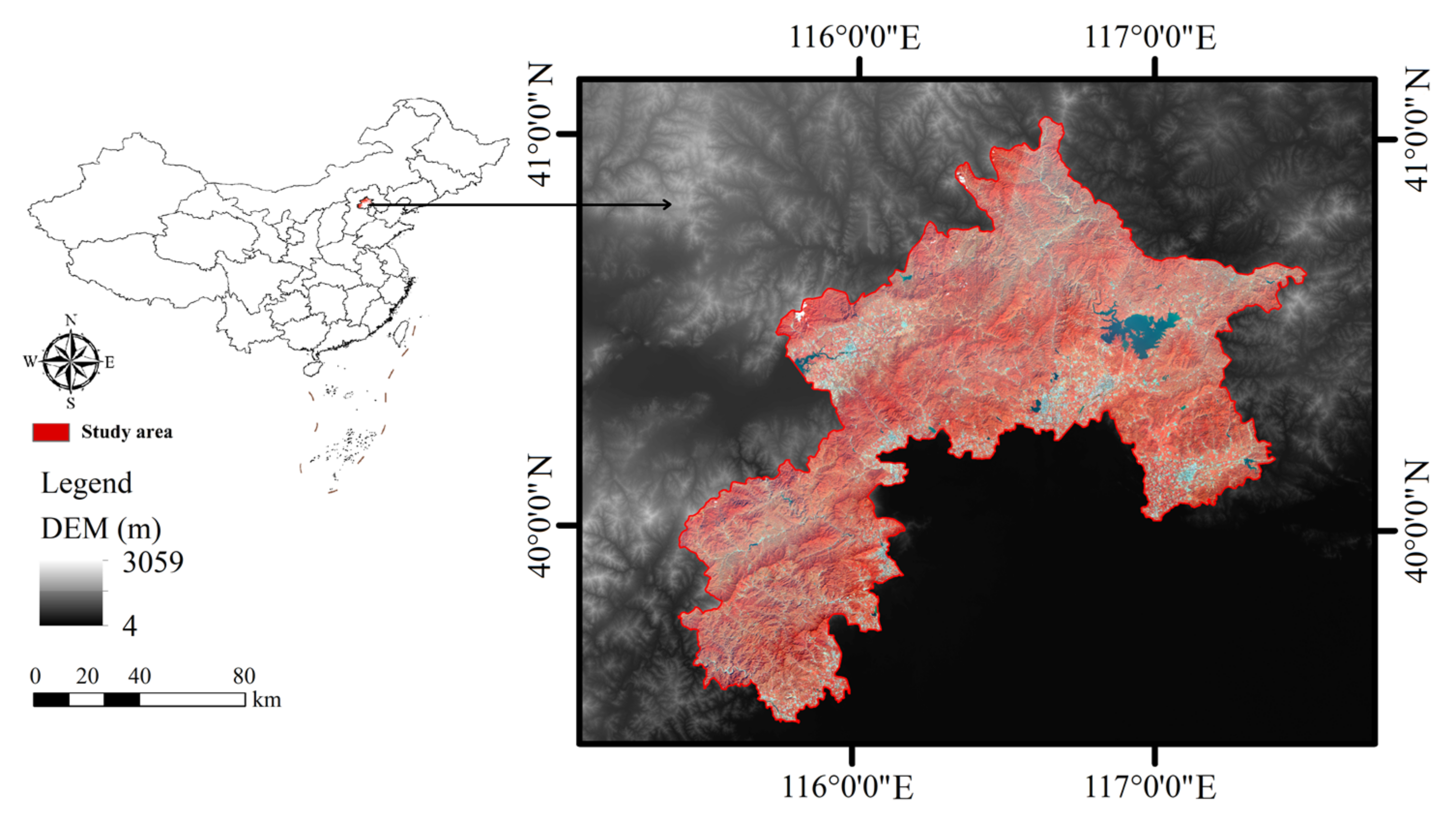
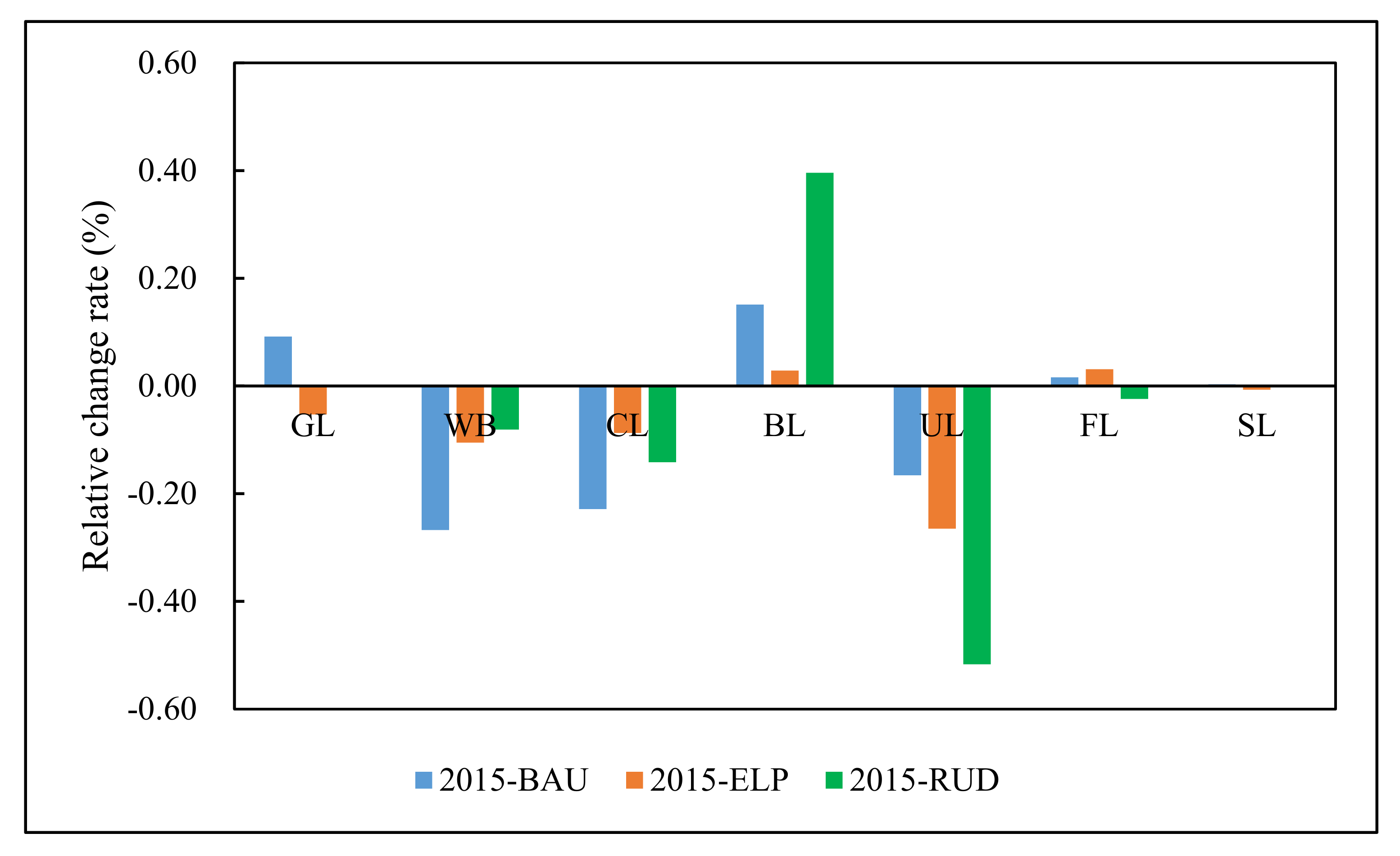
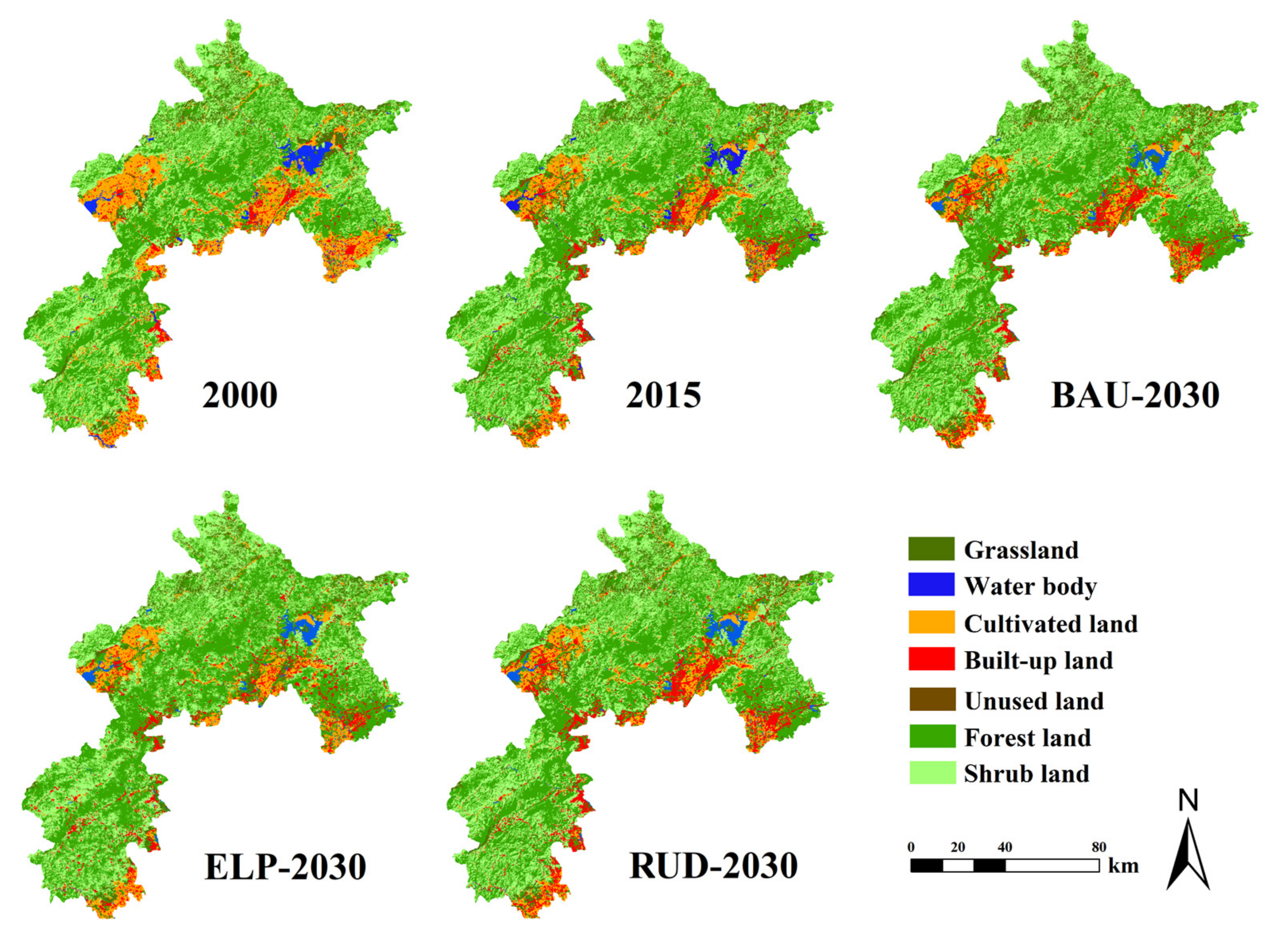
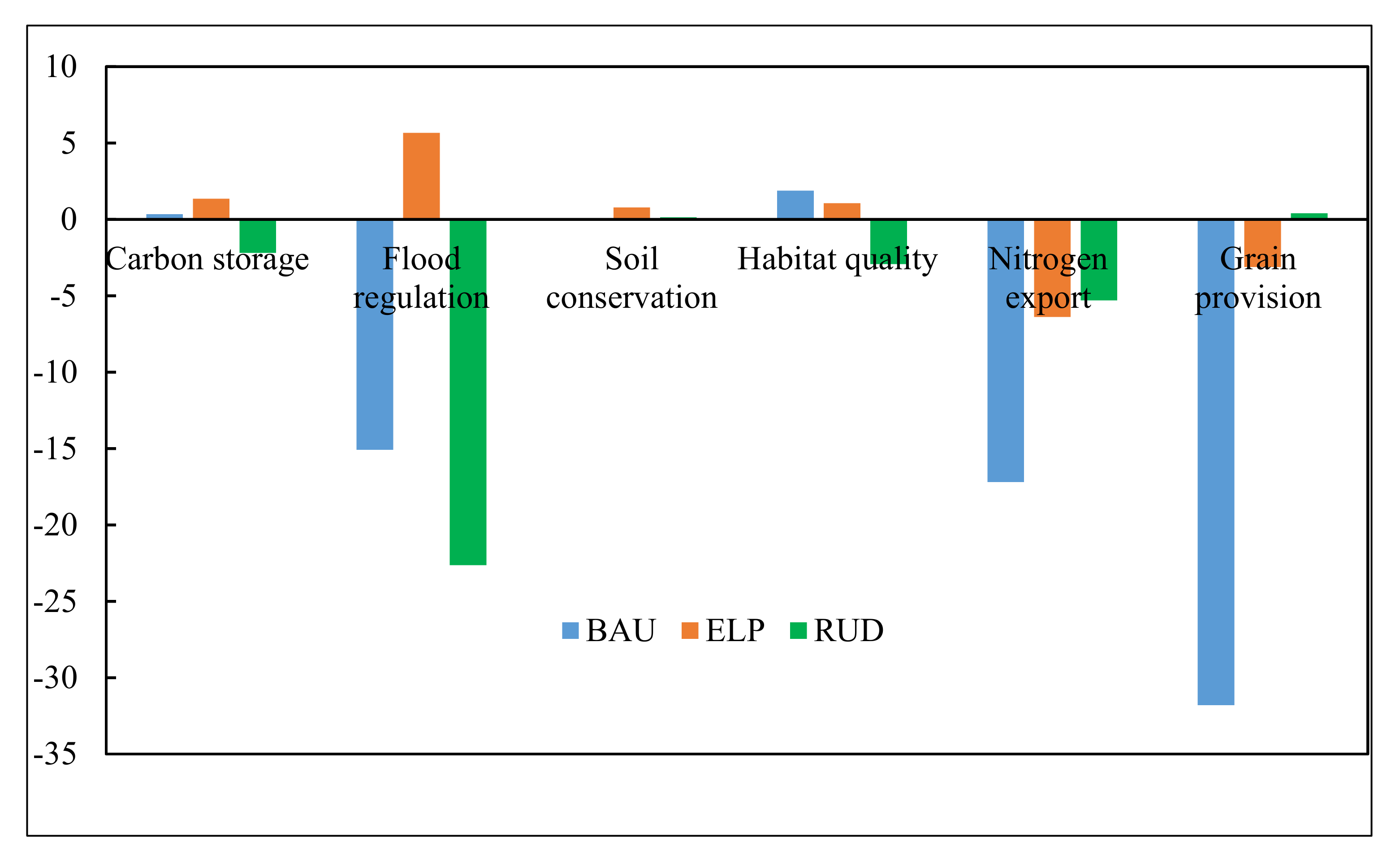
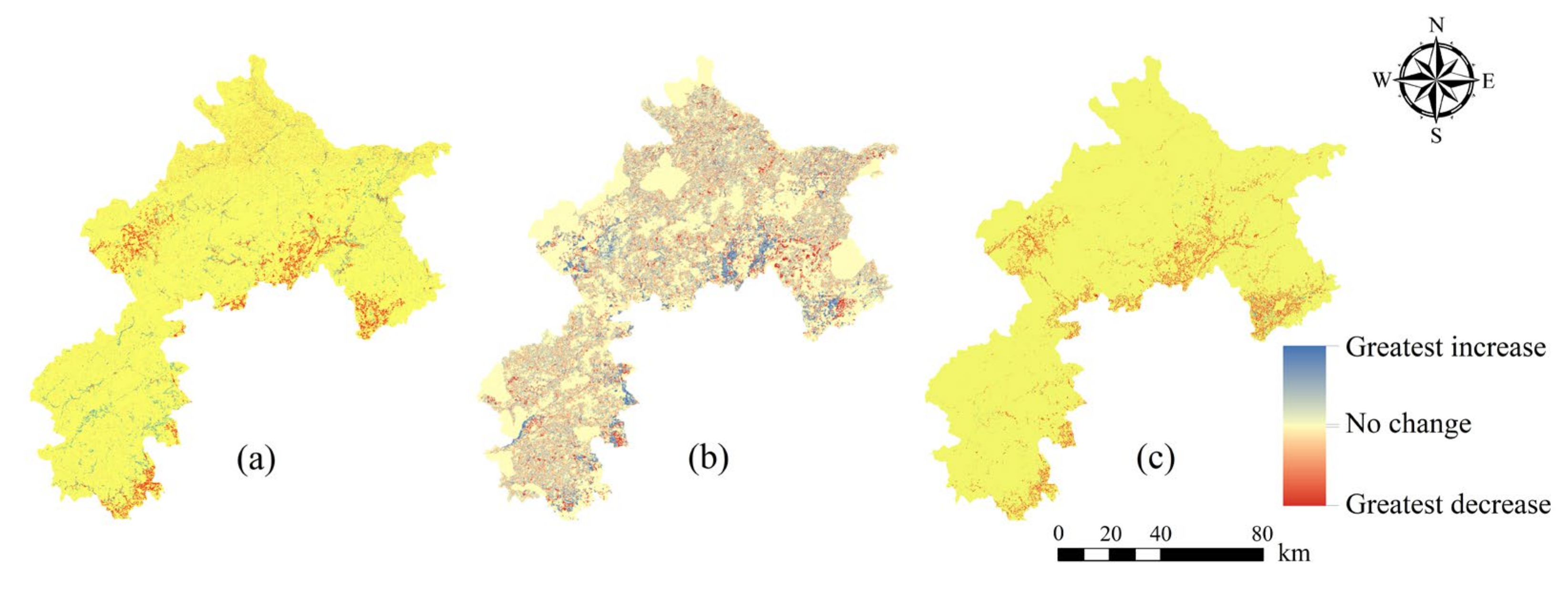

| Types | Description | Sources |
|---|---|---|
| Land-use/cover | Land-use maps in 2000 and 2015 (30 m) | Resources and Environmental Sciences, Chinese Academy of Sciences [32] |
| DEM | Digital Elevation Model (30 m) | Resources and Environmental Sciences, Chinese Academy of Sciences [32] |
| Climate data | Annual precipitation, monthly precipitation, temperature, sunshine hours (1 km) | National Earth System Science Data Center [33] |
| Soil data | Soil texture, sand fraction, silt fraction, clay fraction, root restricting layer depth, plant available water content (1 km) | Harmonized World Soil Database [34] |
| Evapotranspiration coefficient (Kc) | Evapotranspiration for reference crops | Food and Agriculture Organization of the United Nations [35] |
| Soil erodibility (K) | A soil erodibility value for each cell (1 km) | National Earth System Science Data Center [33] |
| Rainfall erosivity (R) | An erosivity index value for each cell (1 km) | National Earth System Science Data Center [33] |
| Potential evapotranspiration (ET0) | Plant evapotranspiration (1 km) | Global Aridity Index and Potential Evapo-Transpiration (ET0) Climate Database v2 [36] |
| Sub-watersheds | Each watershed contributes to a point of interest | HydroSHEDS [37] |
| Carbon pools | Four basic carbon densities for each land cover type | [25,28,38] |
| Scenario | Description | Major Land Cover Changes |
|---|---|---|
| BAU (Business As Usual) scenario | The land-use pattern is only affected by the historical transition rules and simulated without any constraints. | Built-up land would continue to expand from 2015 to 2030 and occupy both cultivated and ecological land. |
| ELP (Ecological Protection) scenario | According to General Planning of Beijing Municipality (2016–2035) and related ecological construction policies, natural reserves, reservoirs, and basic farmland are constraints. | An increase in built-up land and forest land relative to the baseline case scenario. Cultivated land would account for more than 7% of the study area. |
| RUD (Rapid Urban Development) scenario | Due to the rapid increases of population and technologies, the demands for built-up land, including urban and rural residential land, construction land, and transport facility areas would expand rapidly. Basic farmland is prevented from changing to the other. | An increase in built-up land and a slight decrease in cultivated land, respectively, relative to the baseline case scenario. |
| Indicators | Carbon Storage | Flood Regulation | Water Purification | Soil Conservation | Habitat Quality | Crop Production |
|---|---|---|---|---|---|---|
| Weight | 0.1596 | 0.1688 | 0.0875 | 0.1396 | 0.1574 | 0.0964 |
| Indicators | Carbon Storage (108 t) | Flood Regulation (dimensionless) | Soil Conservation (109 t) | Habitat Quality (dimensionless) | Water Purification (103 t) | Crop Provision (106 t) |
|---|---|---|---|---|---|---|
| 2000 | 0.95 | 0.39 | 2.69 | 0.86 | 1.91 | 0.57 |
| 2015 | 0.99 | 0.53 | 2.47 | 0.92 | 1.39 | 0.47 |
| BAU | 0.99 | 0.45 | 2.47 | 0.93 | 1.20 | 0.32 |
| ELP | 1.00 | 0.56 | 2.49 | 0.93 | 1.32 | 0.46 |
| RUD | 0.97 | 0.41 | 2.47 | 0.89 | 1.33 | 0.47 |
Publisher’s Note: MDPI stays neutral with regard to jurisdictional claims in published maps and institutional affiliations. |
© 2020 by the authors. Licensee MDPI, Basel, Switzerland. This article is an open access article distributed under the terms and conditions of the Creative Commons Attribution (CC BY) license (http://creativecommons.org/licenses/by/4.0/).
Share and Cite
Li, Z.; Cheng, X.; Han, H. Analyzing Land-Use Change Scenarios for Ecosystem Services and their Trade-Offs in the Ecological Conservation Area in Beijing, China. Int. J. Environ. Res. Public Health 2020, 17, 8632. https://doi.org/10.3390/ijerph17228632
Li Z, Cheng X, Han H. Analyzing Land-Use Change Scenarios for Ecosystem Services and their Trade-Offs in the Ecological Conservation Area in Beijing, China. International Journal of Environmental Research and Public Health. 2020; 17(22):8632. https://doi.org/10.3390/ijerph17228632
Chicago/Turabian StyleLi, Zuzheng, Xiaoqin Cheng, and Hairong Han. 2020. "Analyzing Land-Use Change Scenarios for Ecosystem Services and their Trade-Offs in the Ecological Conservation Area in Beijing, China" International Journal of Environmental Research and Public Health 17, no. 22: 8632. https://doi.org/10.3390/ijerph17228632
APA StyleLi, Z., Cheng, X., & Han, H. (2020). Analyzing Land-Use Change Scenarios for Ecosystem Services and their Trade-Offs in the Ecological Conservation Area in Beijing, China. International Journal of Environmental Research and Public Health, 17(22), 8632. https://doi.org/10.3390/ijerph17228632






